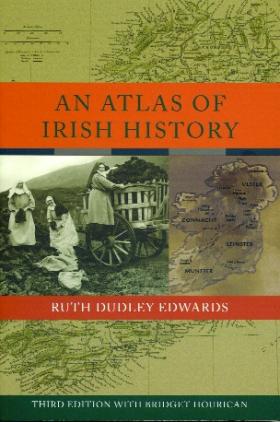An atlas of Irish history
Published in Book Reviews, Issue 1 (Jan/Feb 2006), Reviews, Volume 14 An atlas of Irish history
An atlas of Irish history
Ruth Dudley Edwards, with Bridget Hourican
(Routledge, £14.99)
ISBN 0415278597When it was first published in 1973 this work was welcomed as a snapshot of Irish history, a convenient repository of facts, and as a work that graphically conveyed its information through many elegantly drawn maps. A measure of its success is that its maps, converted into overheads, have illustrated any number of lectures on Irish history since its appearance. Despite a second edition in 1980, after a quarter of a century this book was reaching the end of its usefulness as a work of handy reference. This defect has now been remedied by a thorough reworking and updating by Bridget Hourican.
The book is an interlocking set of seven frames within which to locate Irish history: (1) military, (2) political, (3) religious, (4) land, (5) infrastructure, (6) economic and (7) social change. There are two other frames that cut across these: the Irish abroad and Northern Ireland. In some of these areas there has been need for very little updating, but in others there have been changes that would have been unimaginable in 1973 or 1980. The two most dramatic have been in the chapter on Northern Ireland (where there is a staccato account of events between 1969 and 2005) and religion, where there is an attempt to chart the changes in attitudes to religion/morality and society and the declining fortunes of the Catholic Church, which faces a future with less adherents, less operatives and less esteem than at any point in the last 200 years. When it first appeared someone described it as an ‘excellent reference book’, and it still deserves this accolade and a place on the shelf of anyone trying to understand Ireland and Irish history.
However, the book calls itself an ‘atlas’ of Irish history, and its ‘unique selling point’ is having 89 maps (many of them full-page: 165mm x 115mm) and fifteen graphs in a book of 300 pages. Of these maps, about sixteen are newly drawn for this edition, and most of the graphs are either completely new or have been redone to include more recent statistics. Unfortunately, it is in its cartography that this atlas is showing its age, despite the updating. First, when the maps were produced they were models of clarity, elegantly and expertly drawn in pen and ink by W.H. Bromage. Indeed, they compare very favourable for their ability to communicate with the 1984 Maps, genealogies and lists volume that accompanies the New History of Ireland. However, given advances in cartographic technology that allow very clear and accurate maps to be produced at a fraction of the costs of 1973, the decision to keep the old maps was a mistake. When the 1973 maps are compared with maps produced for this edition, e.g. Fig. 63, Transport (p. 181), the difference in clarity is striking. Second, when the book first appeared its cartographic philosophy was simple, almost naïve: the maps were graphic illustrations of what was contained in the text, even if the text was ostensibly there to accompany the maps (given that it is an atlas). This notion, that maps are illustrations that brighten up a text or a lecture rather than intellectual products in their own right communicating that which linear text cannot, reached its extreme in a few instances where graphs were simply superimposed on an outline map of Ireland (e.g. Fig. 32 or Fig. 57). However, in many other cases the information is placed on a map simply to produce a graphic analogue of what is in the text; and this latter attitude to maps is also found in the new material. For example, in Fig. 88(b) we have a map of ‘Poets of the Troubles’ in Northern Ireland between 1969 and 2005. However, there is no attempt to show any correlation between geographical position and the likelihood of being a poet; it would seem, in fact, to be simply a function of population density because there are more where there are cities. A few of the original maps were distribution maps, but that is not a theme that was consistently followed so there are few cases where we are enabled to make comparisons over time, although the idea has now taken root, as can be seen in the new set of four maps showing the use of the Irish language (Fig. 79). Lastly, there were no comparative density maps in the 1973 edition, but while this idea has also now been taken on board (see Fig. 33) it has not been exploited.
So my conclusion is a mixed one: it is great to have a new edition of this handy book but do not be misled by its title, as it falls far below what most people expect from an atlas.
Thomas O’Loughlin
















